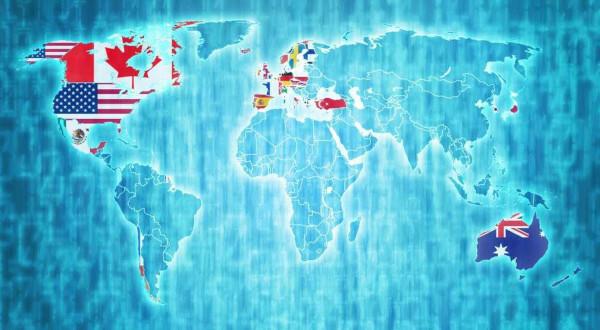The Organization for Economic Cooperation and Development (OECD) represents a structure formed by countries and strategic partners dedicated to economic development. members intend discuss public and economic policies that guide them. These countries support the principles of representative democracy and the rules of the market economy.
This organization is also known as rich club, as its members have a high GDP per capita (gross domestic product per inhabitant) and also high human development indicators, representing around 80% of world trade and investments.
OECD corresponds to the acronym in Portuguese. In English, the training is called the Organization for Economic Co-operation and Development (OECD).
Read too: European countries
Do not stop now... There's more after the advertising ;)
What is it and when it graduated
The OECD is made up of member countries that are committed to promoting international standards that permeate issues economical, financial, commercials, social and also environmental. The meetings held by the organization provide opportunities for discussions among its members, who, by exchanging experiences about their government actions, create possibilities regarding policy management in numerous areas, as well as the solution of possible problems.
These discussions are done through information provided in their database. This information then directs participating governments to promote economic development based on sustainability, looking for a financial stability.
Basically, the organization follows a pattern to guide its meetings: o secretariat collects the necessary and relevant data; you committees discuss the information collected; O advice decides on possible solutions and policy coordination; and, finally, the governments apply the recommendations.
According to the OECD, their way of working is as follows:
Data Collection → Analysis → Discussions → Decisions → Implementations → Multilateral Surveillance |
According to the Ministry of Economy of Brazil, the organizational structure of the OECD comprises:
Technical secretariats;
Agencies;
Research centers;
About 30 international committees specialized in different subjects of the international economy and public policy;
Approximately 200 bodies and 240 legal instruments.
→ Formation
The precedents for the creation of the OECD go back to the periods lived during the Second World War, when countries in Europe reinforced that they should not make the same mistakes they experienced in the First World War. This, according to these countries, would only be possible if their leaders encouraged cooperation and reconstruction of defeated countries, and not punish them. That would be the way to peace.
Then, in 1948, the Organization for European Economic Cooperation (OECE), financed by the States, was created. United, with the objective of rebuilding the continent that was destroyed by the war, creating an era of cooperation. Due to the organization's success in promoting this attitude, the United States and Canada have joined the membership of the OECE. Thus, following this last organization, the OECD, in September 30, 1961. Its headquarters are located in Paris, France.
See too: Difference between export and import
members

The OECD is currently made up of 36 member countries and some partner countries.
Currently, the organization has 36 members, that seek each other in order to identify, discuss and analyze problems, promoting policies capable of solving them. They are: Germany, Australia, Austria, Belgium, Canada, Chile, South Korea, Denmark, Slovakia, Slovenia, Spain, United States, Estonia, Finland, France, Greece, Netherlands, Hungary, Iceland, Ireland, Israel, Italy, Japan, Latvia, Lithuania, Luxembourg, Mexico, New Zealand, Norway, Poland, Portugal, United Kingdom, Czech Republic, Sweden, Switzerland and Turkey.
The organization also has strategic partners, according to the OECD website. They are: South Africa, Brazil, China, India and Indonesia.
know more: birth rate and death rate
Goals
According to the OECD, the organization's objective is to promote politics that provide the socioeconomic well-being gives population at the All the world. There is an offer, by the organization, of a forum, in which governments can exchange experiences in search of solutions to common problems.
Governments seek to understand what drives economic, social and environmental change, as well as measure the productivity and the global trade and investment flows. The organization also promotes the analysis and comparison in Dice for predict future trends. International standards are set in sectors such as agriculture and chemical safety.
The organization too analyzes factors that directly influence the lives of the population, such as taxes, social security and the time these people have devoted to leisure. The comparison of educational systems and social security of countries allows the organization to recommend necessary policies that contribute to improving the quality of life of the population.
All this articulation converges to:
the maintenance of lasting economic growth, aiming at sustainable development;
the creation of jobs and possibilities that contribute to the improvement of the economic sector and social well-being;
improving life expectancy through the promotion of policies that ensure efficiency in health and education;
the fight against poverty, seeking financial stability;
and the improvement of economies in developing countries.
OECD and Brazil
the relationship of partnership between Brazil and the OECD it began with the entry of Brazil into a committee of this organization, the Steel Committee, in 1996, and then started to participate in the meetings. In the year of 2012, Brazil was invited to participate in the Expanded Engagement Program, which strengthened the country's presence in the organization.
In 2015, the Cooperation Agreement was signed, representing the strengthening of the country's political engagement with the OECD. The country currently participates (as much as the member countries) in seven bodies and two projects and is also represented in 17 other bodies.
In May 2017, the country submitted its application to join the organization during the Ministerial Meeting of the Council in order to become a full member. The country adhered to 37 OECD legal instruments that represent the standards and guidelines proposed by the Organization. Recently, the country also requested adherence to 76 of the organization's instruments, such as the Code for the Liberalization of Capital Movements. The country's accession to the OECD represents, therefore, greater credibility for the country, as well as the strengthening of the organization with other important economies and a great opportunity for Brazil to achieve its agenda of reforms.|1|
→ World Trade Organization (WTO)
Currently the Brazilian government has taken decisions in order to finally join the OECD, which it would represent a seal of confidence to the country, as well as attract possible investments and financing international.
In exchange for the support of U.S for this adhesion, support which is very important, the Brazilian government agreed to renounce some of the advantages it enjoyed in the World Trade Organization (organization that oversees international trade, regulating trade agreements between countries), since it proposes a different from countries considered to be developing, such as flexibility in trade negotiations and longer terms in complying with agreements.
Also know:Trade balance
Upon being accepted into the OECD, Brazil will then have an active voice and vote, thus being able to ensure the specificities of the Brazilian economy in the organization's standards. THE entry from Brazil in the OECD it would then represent to entrepreneurs the acceleration of the process of structural reforms and economic growth.|1|
OECD and education
According to the Ministry of Education, the main educational body of the OECD is the Educational Policy Committee (Education Policy Committee). It was created in 2007 and since then it has coordinated all activities related to this area. The objective is to help member countries and partners to promote quality and lasting education.
Thus, in order to support countries in the development of effective educational systems, through the improvement of learning processes and outcomes, this committee makes its data and analysis regarding educational processes available for middle of “Education at a Glance: OECD Indicators”|2|, which represents the main source of information about education around the world. This survey provides data on the structure, financing and performance of education systems in OECD member countries and partner countries.
In Brazil, the MEC has a partnership with the OECD aiming to promote public policies to improve the quality of education in the country. In 1997, the OECD created the International Student Assessment Program (PISA), whose objective is to assess the educational systems of OECD member and partner countries. This program takes an exam to assess knowledge in the fields of science, reading and math every three years. Brazil's participation in PISA dates back to the first application of the exam in 2000.
*Image credits: 360b / Shutterstock
Grades
|1| Working with Brazil — OECD. To access, Click here.
|2| Education at a Glance 2015 — OECD. To access, Click here.
By Rafaela Sousa
Graduated in Geography

